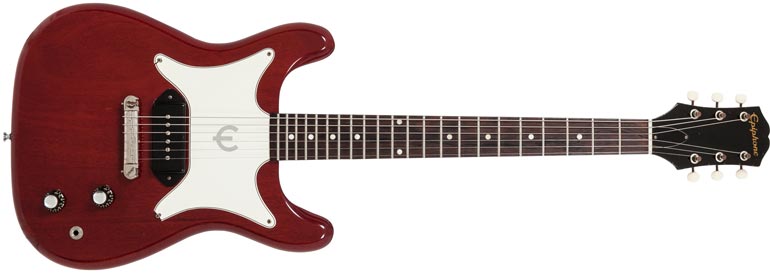
Epiphone guitar manufacture can be spit into four main phases: (i) Stathopoulos family, 1873-1957, (ii) CMI/Gibson, 1957-1969, (iii) Norlin (Matsumoku, Japan), 1970-1985, (iv) Gibson Guitar Corporation, 1986-date. Solid body guitars had been available from Gibson and Fender through the 1950s, but the only Epiphone electric guitars produced prior to 1957 were electric acoustics, typically full body jazz guitars.
When Gibson owner CMI bought Epiphone in 1957, they also bought tooling, unfinished guitars and a lot of parts. Epiphone solid body production did not start until two years after the take-over, with the first two models (Coronet and Crestwood Custom) shipped from the Gibson Kalamazoo plant in 1959. These guitars were joined by the Olympic and Wilshire a year later, and the Crestwood Deluxe in 1963. These guitars used much of the same woods, construction methods and hardware as the Gibson models that were produced side-by-side in Kalamazoo. As mentioned, Gibson inherited numerous Epiphone parts, and many early examples were fitted with Epiphone New York pickups, headstock badges and Epiphone knobs.
In terms of design, the Gibson-made Epiphone solid body guitars were quite unique. There were two versions, the first was a compact guitar with deep, symmetrical cutaways and large symmetrical pickguard - built between 1959 and 1962. From 1963 the guitars were lengthened, specifically with a new 'batwing' headstock, but also loosing it's symmetry, with the stubby cutaways, longer on top, and almost non-existent on the bottom.

1962 Epiphone Coronet with the early symmetrical body shape. Image Heritage auctions

1965 Epiphone Crestwood Deluxe with the better known asymmetrical design. Image Heritage auctions
In terms of construction and specifications, the Epiphone solid bodies were more or less analogous to the Gibson SG and Melody Maker guitars. They had the same basic construction: mahogany bodies and necks, with a (usually) rosewood fretboard, and the same translucent Cherry finish. They were wired more or less the same and listed at more or less the same prices. Actually, where there was a difference, the Epiphones tended to be the higher priced of the two. The table below compares the different models.
| Epiphone model | Equivalent Gibson model | ||||
|---|---|---|---|---|---|
| model | specifications | 1963 price | model | specifications | 1963 price |
| Epiphone Olympic | 1 or 2 PU-380 pickup | $139.50, $169.50 double pickup | Gibson Melody Maker | 1 or 2 PU-380 pickup | $119.50, $155 double pickup |
| Epiphone Olympic Special | 1 PU-380 pickup | $119.50 | Gibson Melody Maker | 1 PU-380 pickup | $119.50 |
| Epiphone Coronet | 1 P90 | $162.50, 189 with vibrola | Gibson SG Junior (TV) | 1 P90 | $155 |
| Epiphone Wilshire | 2 P90 or 2 mini humbuckers | $249.50, $277 with vibrola | Gibson SG Special | 2 P90 | $225 |
| Epiphone Crestwood Custom | 2 mini humbuckers, tremotone vibrola | $345 | Gibson SG Standard* | 2 humbuckers | $310 |
| Epiphone Crestwood Deluxe | 3 mini humbuckers, ebony fretboard, nickel plated hardware | $450 | Gibson SG Custom* | 3 humbuckers, ebony fretboard, gold plated hardware | $450 |
* SG Standard and Custom were still officially called Les Paul Standard and Custom at this point, though would be renamed shortly afterwards
In the late 1960s, American guitar manufacturers were in financial trouble. Imported Japanese guitars were consistently undercutting the US built ones, with quality improving all the time. So in 1969, Epiphone production ceased at Kalamazoo, being replaced by a series of guitars built by Aria in the Matsumoku plant in Japan. These guitars were loosely based on the US models, but at a significantly lower price.
The first guitar was the 1802T debuting in 1970. This was fairly quickly renamed the ET-270, with newer models ET-275 and ET-278 added to the line in 1972, and the ET-290 added in 1973.

1976 price lists show new models, the ET-276, and ET-285. In 1977 the Scroll series was launched (SC-350, SC-450, SC-550, later SCIIB), followed by the Genesis series in 1979 (Standard, Deluxe and Custom).
American-built Epiphone guitars had a brief revival in 1983, with the American series: Challenger, Corvus, Spirit, Special. These models were quickly discontinued, being rebranded as Gibson guitars, to be replaced by the Wilshire II, Wilshire III and Crestwood II in 1984 - once more made in Japan.
Once Norlin sold out to the current owners (Gibson Guitar Corporation), Epiphone guitar manufacture was firmly based in Asia, specifically Korea and China. Today, the Epiphone guitar range is more popular than ever, selling lower priced versions of many USA-built Gibson models in large numbers.
$1450
$8999
$2795
$1699
$2695
$1499
$996
$2500
$4500
$7019
$5800
$1600
$4199
$3995
$3300
$860
$35
$100
$1200
$3779